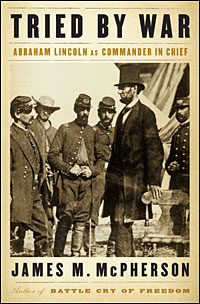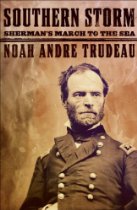James M. McPherson’s Tried By War sought to explain how Lincoln established the function of the President as “Commander-in-Chief.”
In Tried By War I was intrigued by McPherson’s description of Lincoln’s evolving role during the Civil War as Commander-in-Chief. He writes on page 5 in the Introduction, “He [Lincoln] performed or oversaw five wartime functions in this capacity, in diminishing order of personal involvement: policy, national strategy, military strategy, operations, and tactics.”
This statement struck me as familiar but I could not at the time place it. This weekend I realized that Eliot A. Cohen in his Supreme Command: Soldiers, Statesmen, and Leadership in Wartime, 2002, said something very similar. Writing in his chapter on Lincoln, Cohen states, “His [Lincoln's] fundamental concept [of being commander-in-chief] was simple, and may be reduced to the following five interlocking propositions…” And he goes into detail that comes close to some of the same ideas McPherson expressed.
1. Cohen listed as the first concept as the “war’s aim” which is exactly as McPherson defines “policy.”
2. The “war had to begin with acts of Southern aggression” in order to keep the Northern states, including the volatile border state, unified.
3. “The Confederacy must be deprived of external support…”
4. The Union armies needed to engage their Southern counterparts and “crush” them.
5. To accomplish this Northern armies “by a concerted offensive around the circumference of the South, thereby allowing the numerical and material superiority of the Union to come into play.” This of course is in reference to the concentration in “time” that McPherson mentions, among others.
Yet I also remembered Allan R. Millett and Peter Maslowski’s For Common Defense: A Military History of the United States of America where in their introduction they essentially defined the role of Commander-in-Chief: “Policy is the sum of the assumptions, plans, programs, and actions taken by the citizens of the United States,” which of course would be established by the President; “War aims are the purposes for which wars are fought,” yet another concept that the President must establish and articulate to the people; “operational doctrine, which is an institutional concept for planning and conducting operations,” and once again in a Clausewitzen view, is very much something the President would be involved in; “Strategy, the general concept for the use of military force, is derived from war aims,” and therefore falls within the realm of the President; and finally, “Tactics, is the actual conduct of battle,” which on the surface appears to have little to do with the President, yet during the Civil War when Lincoln made it clear that the policy of conciliation was no more, the tactics used by Grant, Sherman and Sheridan changed to reflect the President’s beliefs.
 Tried by War is timely and offers a fresh look at the role of the executive branch in time of war and the origins of the Commander-in-Chief role that we see today certainly owes its authority to Lincoln.
Tried by War is timely and offers a fresh look at the role of the executive branch in time of war and the origins of the Commander-in-Chief role that we see today certainly owes its authority to Lincoln. Too often American Indians are portrayed as unmindful nomads without sophistication, education, art, and culture. Europeans landed, took over, and the rest is as they say history. But what Mann does an excellent job of pointing out, is that the Indians were not helpless and did play a role in history. They made alliances, war, and peace, and the results of which played a role in their demise. They played a role, which is the key, they were not helpless.
Too often American Indians are portrayed as unmindful nomads without sophistication, education, art, and culture. Europeans landed, took over, and the rest is as they say history. But what Mann does an excellent job of pointing out, is that the Indians were not helpless and did play a role in history. They made alliances, war, and peace, and the results of which played a role in their demise. They played a role, which is the key, they were not helpless.